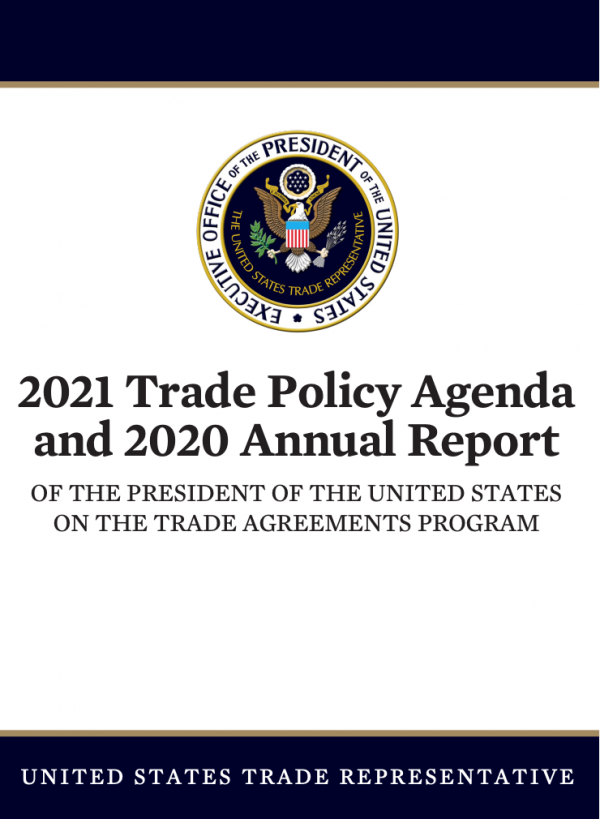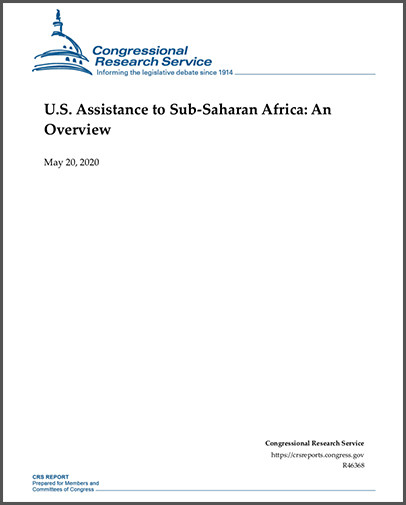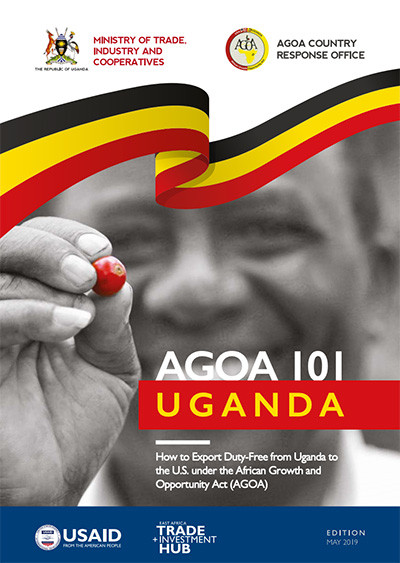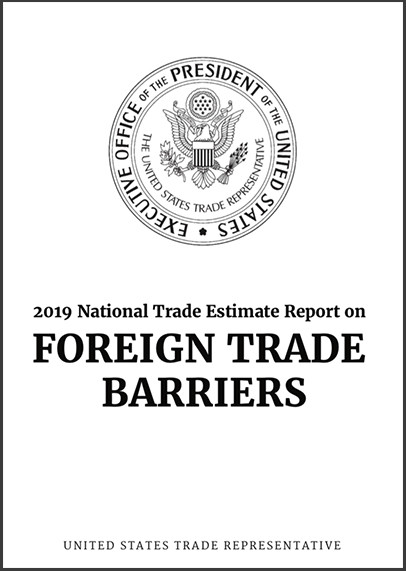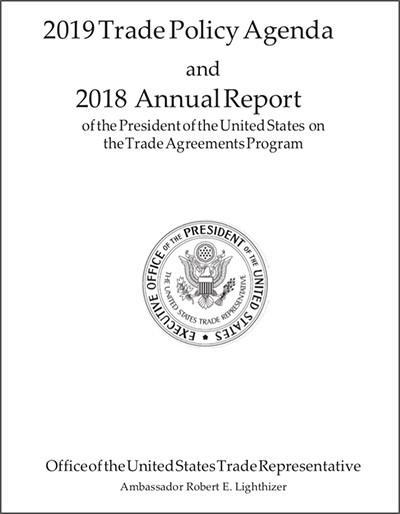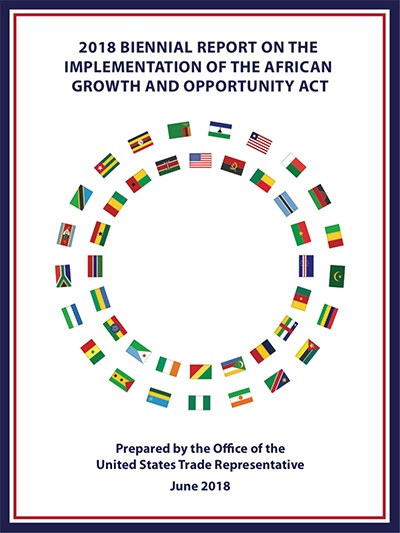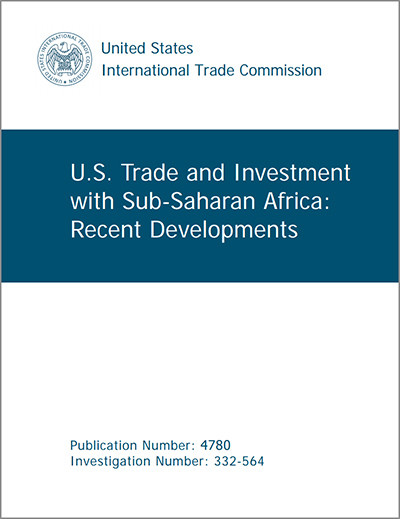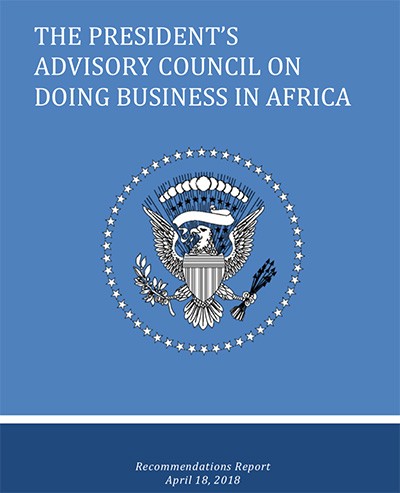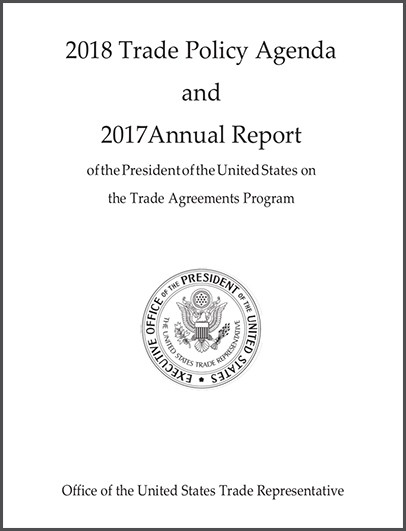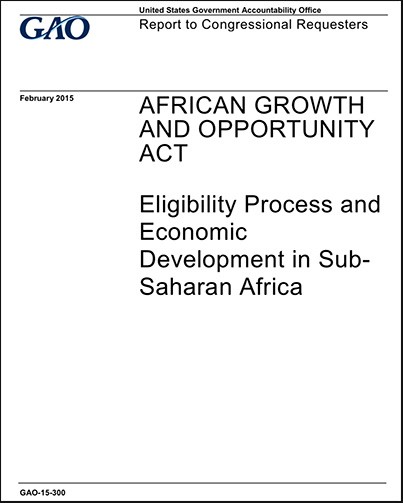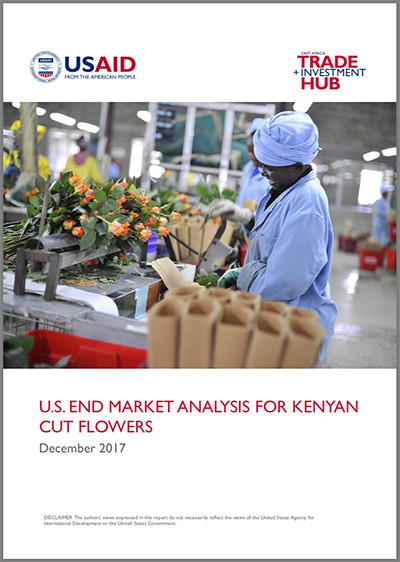Documents & Reports
2021 Trade Policy Agenda and 2020 Annual Report
The 2021 Trade Policy Agenda and 2020 Annual Report of the President of the United States on the Trade Agreements Program are submitted to the Congress pursuant to Section 163 of the Trade Act of 1974, as amended (19 U.S.C. § 2213). Chapter IV and Annex III of this document meet the requirements of Sections 122 and 124 of the Uruguay Round Agreements Act with respect to the World Trade Organization. The discussion on the Generalized System of Preferences in Chapter II satisfies the reporting requirement contained in the Consolidated Appropriations Act, 2018 (Pub. L. 115-141, div. M, title V, § 501(c)). This report includes an annex listing trade agreements entered into by the United States since 1984. Goods trade data are for full year 2020. Full-year services data by country are only available through 2019.
US Assistance to Sub-Saharan Africa: An Overview
Overview: Congress authorizes, appropriates, and oversees U.S. assistance to sub-Saharan Africa (“Africa”), which received over a quarter of U.S. aid obligated in FY2018. Annual State Department- and U.S. Agency for International Development (USAID)-administered assistance to Africa increased more than five-fold over the past two decades, primarily due to sizable increases in global health spending and more incremental growth in economic and security assistance. State Department and USAID-administered assistance allocated to African countries from FY2019 appropriations totaled roughly $7.1 billion. This does not include considerable U.S. assistance provided to Africa via global accounts, such as emergency humanitarian aid and certain kinds of development, security, and health aid. The United States channels additional funds to Africa through multilateral bodies, such as the United Nations and World Bank.
US Trade and investment with Sub-Saharan Africa: Recent developments 2020 Report
This report provides information on U.S. trade and investment with sub-Saharan Africa (SSA). In particular, it analyzes the sectors in which U.S. trade in goods and services with SSA showed the strongest growth during 2016–18; identifies SSA countries for which U.S. exports, imports, and outward foreign direct investment (FDI) increased the most during the period; and highlights the main factors behind this growth. Focusing on several SSA countries, including South Africa, Nigeria, Kenya, Ghana, Rwanda, Ethiopia, and Côte d’Ivoire (called “key markets” in this report), the Commission used case studies to provide in-depth analysis of trends in four important areas: (1) the ways U.S. products and services integrate into key SSA value chains; (2) the intellectual property environment in the key SSA markets, and the effects of that environment on trade and investment; (3) technological innovations in SSA agricultural production and exports; and (4) the digital economy in SSA. In examining SSA’s digital economy, the report explores how the adoption of digital technologies affects other industries and how policies and market conditions affect digital trade. Further, this report summarizes recent developments in regional integration efforts in SSA, particularly the negotiation and implementation of the African Continental Free Trade Area. It also includes a summary of SSA countries’ utilization of preferential trade provisions under the African Growth and...
Mozambique: Politics, Economy, and US Relations
Mozambique, a significant recipient of U.S. development assistance, is a southeastern African country nearly twice the size of California, with a population of 27.9 million people. It achieved rapid growth following a post-independence civil war (1977-1992), but faces a range of political, economic, and security challenges. These include a political scandal over state-guaranteed, allegedly corrupt bank loans received by state-owned firms, which created public debt that the government did not disclose to the International Monetary Fund (IMF). This placed the country’s relations with the IMF at risk and has had major negative repercussions for the economy, donor relations, and Mozambique’s governance record. Other challenges include unmet development needs, a range of governance shortcomings, organized crime, an ongoing economic slump, and political conflict and violence involving both mainstream political actors and violent extremists.
AGOA 101 - Uganda Guide
The African Growth and Opportunity Act (AGOA) provides duty-free access to the U.S. market for over 6,000 products. This AGOA 101 manual outlines the step-by-step process that Ugandan businesses should take to export to the U.S. through AGOA. The guide provides additional information on the export of four high-demand, high-value sectors, namely coffee, cut flowers, fish, and textiles and apparel. Although exporting can be a challenging process, it can also be profitable if the individual or company successfully complies with the steps. Exporters must follow two sets of requirements: Ugandan laws and regulations that govern the export process, and laws and regulations that govern the destination country’s imports, in this case, the U.S. Regulations also vary according to the product being exported; exporters must research to ensure that their product meets the necessary requirements for export. This guide assumes that the exporter or potential exporter has already conducted the necessary market research, and is ready to export. Before proceeding, exporters must identify the correct tariff code and its eligibility for duty-free export under AGOA. This status can be established by referring to www.agoa.info/about-agoa/products.html. On that page, the user should insert the product name, search for the correct tariff code and confirm its AGOA status, denoted by the letter “D” in the AGOA indicator column. Exporters should familiarise themselves with U.S. industry...
2019 US National trade estimate report on foreign trade barriers
The 2019 National Trade Estimate Report on Foreign Trade Barriers (NTE) is the 34th in an annual series that highlights significant foreign barriers to U.S. exports, U.S. foreign direct investment, and U.S. electronic commerce. This document is a companion piece to the President’s 2019 Trade Policy Agenda and 2018 Annual Report, published by Office of the United States Trade Representative (USTR) in March.
2019 US Trade Policy Agenda and 2018 Annual Report
On March 1, 2019, the United States Trade Representative released President Trump’s 2019 Trade Policy Agenda and Annual Report, outlining how the Administration’s trade policies are benefitting American workers, contributing to the strongest U.S. economy in decades, and rebalancing America’s trade relationships and the global economy.
2018 AGOA Implementation Report
Section 110 of the Trade Preferences Extension Act of 2015 (“the Act”), 19 U.S.C. § 3705 note, states that the President1 shall submit a report to Congress on the trade and investment relationship between the United States and sub-Saharan African countries no later than one year after the enactment of the Act, and biennially thereafter. The U.S. Trade Representative, on behalf of the President, submitted the first report under this provision in June 2016. The current report covers the period since then. It provides a description of the status of trade and investment between the United States and sub-Saharan Africa, changes in country eligibility for AGOA benefits, an analysis of country compliance with the AGOA eligibility criteria, an overview of regional integration efforts in sub-Saharan Africa, and a summary of U.S. trade capacity building efforts.
US trade and investment with Africa: recent developments
This report was prepared by the U.S. International Trade Commission (Commission) at the request of the U.S. Trade Representative (USTR) in a letter received by the Commission on October 23, 2017. The USTR requested that this report provide information on the sectors in which U.S. trade in goods and services with sub-Saharan Africa (SSA) showed the fastest growth during the period 2010–16; highlight the key factors behind that growth; and identify the sectors and SSA markets that present the greatest potential for U.S. trade and foreign direct investment (FDI) with SSA. Further, the report describes exports of goods and services from U.S. small and medium-sized enterprises (SMEs) to SSA, provides country profiles of seven SSA countries, and summarizes SSA countries’ AGOA utilization strategies as well as the status of regional integration efforts.
The President's Advisory Council on doing business in Africa
The President’s Advisory Council on Doing Business in Africa advises the President, through the Secretary of Commerce, on ways to strengthen commercial engagement between the United States and Africa. Members receive no compensation for their efforts on the Council. This report was prepared by the private-sector members of the Council. The views expressed in this report do not necessarily reflect those of the Administration or individual members of the Council.
2018 Trade Policy Agenda and 2017 Annual Report
The 2018 Trade Policy Agenda and 2017 Annual Report of the President of the United States on the Trade Agreements Program are submitted to the Congress pursuant to Section 163 of the Trade Act of 1974, as amended (19 U.S.C. 2213). Chapter V and Annex II of this document meet the requirements of Sections 122 and 124 of the Uruguay Round Agreements Act with respect to the World Trade Organization. In addition, the report also includes an annex listing trade agreements entered into by the United States since 1984. Goods trade data are for full year 2017. Services data by country are only available through 2016.
Eligibility Process and Economic Development in Sub-Saharan Africa
The U.S. government uses the annual eligibility review process required by the African Growth and Opportunity Act (AGOA) to engage with sub-Saharan African countries on their progress toward economic, political, and development reform objectives reflected in AGOA's eligibility criteria. Managed by the Office of the United States Trade Representative, the review process brings together officials from U.S. agencies each year to discuss the progress each country is making with regard to AGOA's eligibility criteria and to reach consensus as to which countries should be deemed eligible to receive AGOA benefits. Over the lifetime of AGOA, 13 countries have lost AGOA eligibility, although 7 eventually had it restored (see figure). To encourage reforms, the U.S. government will engage with countries experiencing difficulty meeting eligibility criteria and may specify measures a country can take. For example, U.S. officials met with Swaziland officials over several years to discuss steps to improve labor rights. However, Swaziland did not make the necessary reforms and lost eligibility effective in January 2015.
US trade and investment with Sub-Saharan Africa: Recent developments
US end-market analysis for Kenyan textiles and apparel
The apparel market in the United States (U.S.) is the largest in the world with a market value of $343 billion. In 2016, the U.S. imported apparel worth $105 billion, up from $88 billion in 2015 and $82 billion in 2014.1 U.S. consumers spent $312 billion on apparel. Ten countries account for almost 80 percent of all U.S. apparel imports with China topping the list with a 30 percent share. While Kenya does not yet stand among these countries, there is an opportunity for Kenya to take advantage of its trade preferences under the African Growth and Opportunity Act (AGOA) to increase its exports to the U.S. market. Since AGOA was signed for an additional ten-year term in 2015, there has been a growing trend toward sourcing and importing apparel to the U.S. If more stakeholders in both countries realize AGOA’s full potential, Kenyan apparel exports can continue to climb. This report focuses on six target product opportunities for Kenyan exporters: Knitted Shirts in Synthetics for all genders and ages T-shirts in Cotton and Synthetic for all genders and ages Sweaters in Synthetic for all genders and ages Woven Pants and Shorts in Cotton and Synthetic for all genders and ages Woven Shirts in Cotton and Synthetic for all genders and ages Dresses for Women and Girls in Cotton and Synthetic as part of SME products These products were determined by volumes and trends and are not unique to Kenyan production. However, these products offer opportunities for large duty...
US end-market analysis for Kenyan cut flowers
Cut flowers are a major export industry in Kenya. Kenya presently ranks first among world exporters of roses to the European Union (EU), with a market share of 38 percent. However, the country has not yet made as deep of inroads into the cut flower market in the United States (U.S.). Kenyan cut flower exports to the U.S. have grown since 2010, but the country’s market share remains small, standing at 1 percent. This report analyzes emerging opportunities to increase Kenyan flower exports to the U.S. while taking advantage of the benefits granted under the African Growth and Opportunity Act (AGOA). In 2016, Kenya ranked as the twelfth greatest supplier of cut flowers to the U.S. Nearly 90 percent of the cut flowers imported by the U.S. come from three countries: Colombia (59 percent), Ecuador (22 percent) and the Netherlands (7 percent). Colombia and Ecuador, who make up more than 80 percent of the imported flowers, present stiff competition. The countries profit from longstanding commercial relationships with the U.S. and geographic proximity, which reduces freight and transport costs. Both countries enjoy duty-free access to the U.S. market, as does Kenya. Nonetheless, Kenya has a strong, competitive cut flower industry that is ready to explore new markets. The industry is profitable and technically competent, it has developed efficient logistics to the European markets and it offers high-quality flowers at competitive prices. If the industry can use these strengths...
US end-market analysis for Kenyan home decor and fashion accessories
This report provides market data at a product level for use by Kenyan exporters interested in the United States (U.S.) market and to support the National African Growth and Opportunity Act (AGOA) Strategy and Action Plan for Kenya. The home décor and fashion accessories sector has the capacity to further the goals of increasing women and youth participation in manufacturing by providing greater access to economic opportunities. In 2016, the top preforming Kenyan product categories in this sector represented $5.2 million in exports to the U.S. The U.S. is the largest importer in the world in all categories, and the fourth largest in jewelry. This report analyzes the top supply growth opportunities for Kenya based on the U.S. import demand. It also presents the current market trends in the U.S. for Kenya to better compete internationally. In addition, the Kenya Vision 2030 makes the recommendation for "a better and more inclusive wholesale and retail trade sector." Accomplishing the goal of increasing efficiency, lowering transaction costs and strengthening trade as well as linking trade to wider local and global markets requires: Understanding the demands of the international market and the trends that influence the global exports to the U.S. market; Understanding the advantages of the Kenyan market in key product categories, competitiveness in raw material sourcing, and the international competitors participating on the global stage; Sharing a detailed explanation...


